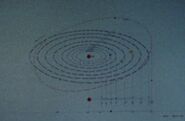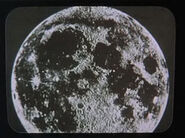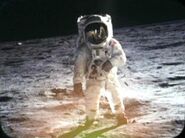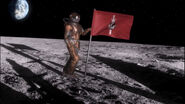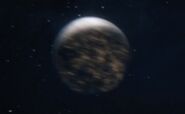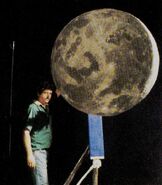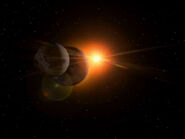Luna, known colloquially as "The Moon" and elsewhere as Terra Luna, was an inhabited large natural satellite of Earth in the Sol system.
Most who had lived on Luna did not actually call it "Luna", this being a term that mostly those on Earth said. Instead the term "the Moon" was retained, a fact that surprised many outsiders. (DS9: "Valiant")
History[]
Visiting the Moon[]

John F. Kennedy giving his 1961 "Decision to Go to the Moon" speech
In 1961, US President John F. Kennedy delivered a speech in which he announced his intention to land a man on the moon by the end of the decade. (TOS-R: "The Cage") In light of this, the Moon was depicted in whole, or in part, on the Apollo program assignment patches. (ENT: "First Flight")
Luna was a central theme in the mission insignia for the Apollo program in the mid-20th century. The first depiction of Luna was in the program's insignia. The insignia depicted the path of the spacecraft from a launch site in Florida to a landing site on Luna. Sun god Apollo was drawn into the features of Luna. As each mission grew closer to landing, the features of Luna became more detailed with cratering and suggested the ship either orbiting above or landing on Luna. (ENT: "First Flight")
The first manned Human landing took place in 1969 by Apollo 11, a NASA mission initiated by the Earth country of the United States of America. (TOS: "Tomorrow is Yesterday", "Return to Tomorrow")

Aldrin sets foot on the moon
The first man to walk on the Moon was Neil Armstrong, who said "That's one small step for [a] man, one giant leap for mankind." Shannon O'Donnel remembered watching it on television when she was eleven years old, and still had dreams about it inspiring her career with NASA in 2000. (VOY: "11:59")
By Apollo 15, the lunar features were the dominant image of the insignia. The last lunar mission, Apollo 17, suggested that the program was the first step in man's progression to the stars with Apollo looking beyond Luna to Saturn and to a distant galaxy. (ENT: "First Flight")
In the mirror universe, the Terran Empire landed on their Moon, planting a flag there to signify their achievement. (ENT: "In a Mirror, Darkly" opening credits)
In 2063, Luna's gravitational field obscured the USS Enterprise-E's warp signature so that the Vulcan starship, the T'Plana-Hath, would not detect it while in Earth orbit as they were making First Contact with Humans. (Star Trek: First Contact)
Post-colonization[]
The lunar colony of New Berlin was built there, sometime after 2063, but before 2069. (ENT: "Terra Nova")

Luna fired upon by the verteron array
At some point before 2154, Major J. Hayes completed a lunar survival training as part of his MACO training. (ENT: "Harbinger")
By 2155, Luna had evolved from a mere colony to a fully self-sustaining world. "Terra Prime", a xenophobic group of Humans which manifested that year, originated from the Orpheus Mining Complex on the Moon. Their leader, John Frederick Paxton, used the hijacked verteron array on Mars to fire on Luna, as a demonstration of the array's power. (ENT: "Demons")
In 2259 of the alternate reality, the USS Enterprise and the USS Vengeance were engaged in a firefight outside Luna's orbit. (Star Trek Into Darkness)
In 2287, the Galileo rendezvoused with the USS Enterprise-A near Luna. (Star Trek V: The Final Frontier)
The USS Enterprise-D passed Luna on its way to Earth in 2364. (TNG: "Conspiracy")
The USS Defiant passed Luna on its way to Earth in 2371. (DS9: "Past Tense, Part I")
When attempting a lucid dream to contact a species of aliens in 2374, Chakotay used the image of the Moon to alert him to the fact that he was dreaming. Chakotay saw the Moon three times – once outside the USS Voyager from the mess hall, once on a monitor screen in Cargo Bay 2 after he'd apparently woken up to warn him he was still asleep and under the aliens' control, and once more on the main viewscreen in the bridge when he dozed off and was slipping back into the aliens' grip. (VOY: "Waking Moments")
Earth and Luna were threatened by the second Dark Matter Anomaly in 3190, causing Starfleet to mount an evacuation effort. (DIS: "Coming Home")
Inhabitants[]
In Earth slang, people who lived on the moon were called Lunar schooners, though the nickname was not used by Lunar inhabitants themselves. (DS9: "Valiant")
As of 2373, over 50 million people lived on the Moon. (Star Trek: First Contact)
Individuals born on Luna included Dorian Collins, Beverly Crusher, Jack Ransom, and Bruno Salvatore. (TNG: "Conundrum"; TNG-R: "Eye of the Beholder"; DS9: "Valiant"; LD: "wej Duj")
In the 25th century, Crusher kept artwork of the Moon among her personal effects aboard the SS Eleos XII. (PIC: "The Next Generation", "Disengage")
Production research indicated the artwork was an intentional reference to the fact that Crusher was born on the Moon. [1]
Geographical[]
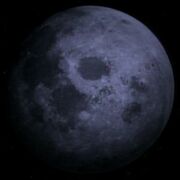
The Moon in 2371
The Moon was similar in size to Weytahn. (ENT: "Cease Fire")
Outside the pressure domes of the Lunar Colonies, the gravity was low and there was no air for Humans to breathe. The sun came up once a month. This event, known as the lunar morning, was a special occasion for people living on Luna. Dorian Collins and her father would hike across the Sea of Clouds towards a scenic spot on the western rim to witness the lunar morning. She described it as meeting God. (DS9: "Valiant")
On a clear day on Earth, a person could see Tycho City, New Berlin, and Lake Armstrong. (Star Trek: First Contact)
Locations[]
- Armstrong City
- Copernicus City
- Copernicus Ship Yards
- Lake Armstrong
- Luna Bay
- Luna Shipyards
- Lunaport
- Lunar colonies
- Lunar One Colony
- Lunar Receiving
- New Angeles
- New Berlin
- Orpheus Mining Complex
- Sea of Clouds
- Tranquility Base
- Tycho Base
- Tycho City
Furthermore, the Sea of Tranquillity was also mentioned indirectly, through the USS Mare Tranquillitatis, Tycho crater was mentioned in an unseen portion of the Picard family album, and a Lunar monitor relay was mentioned in the shooting script of Star Trek: The Motion Picture.
| The Sol System |
|---|
| Sol |
| Mercury • Venus • Earth (Luna) • Mars (Deimos) • Asteroid belt • Jupiter (Io; Ganymede; Europa) • Saturn (Mimas; Rhea; Titan) • Uranus • Neptune (Triton) • Pluto |
Appendices[]
Background information[]
Luna appeared in the opening sequence of the remastered Star Trek: The Next Generation, seen surrounding Earth and Sol and followed by Jupiter and Saturn before the USS Enterprise-D started its exploration of unknown space.
The Star Trek Encyclopedia, 4th ed., vol. 2, p. 51 classified Luna as a planetoid.
According to Star Trek: Star Charts (pp. 32, "United Federation of Planets I"), The Moon (or Sol IIIa) was classified as a D-class moon. In 2039, the Lunar Colonies, the government of the Moon, was founded. Tycho City was the seat of government. In 2161, the Moon was a charter member of the United Federation of Planets. In 2378, Humans were the dominant species, and there were counted 50.2 million living on the Moon. Points of interest included Tranquility Base, Lake Armstrong, New Berlin, and Lunaport.
External links[]
- Luna at Memory Beta, the wiki for licensed Star Trek works
- Moon at Wikipedia

